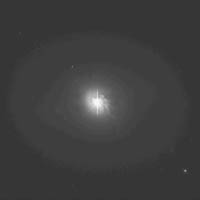Imagine the Universe News - 02 July 2002
Scientists Observe Light Fighting to Escape Black Hole's Pull
| 02 July 2002 |

|
|
Seyfert galaxy NGC 3516 (center source) in the northern sky. The galaxy's bright core is characteristic of an Active Galactic Nucleus, or AGN, whose brightness is most likely powered by a supermassive black hole. (IMAGE CREDIT: Hubble Space Telescope, by Matt Malkan PI, UCLA Astronomy, obtained with the PC2 through a broad red filter.) |
Scientists have found new evidence that light emanating from near a black hole loses energy climbing out of a gravitational well created by the black hole, a key prediction of Einstein's theory of general relativity.
This observation of warped space, made with the Chandra X-ray Observatory and the XMM-Newton satellite, also offers a novel glimpse inside that chaotic swirl of gas surrounding a black hole, called an accretion disk: The scientists captured bright hotspots in small, localized regions within the disk, a crucial step needed to map such a region.
T. Jane Turner of NASA Goddard Space Flight Center and the University of Maryland, Baltimore County, is the lead author of an Astrophysical Journal letter published this week discussing these results.
This latest support for general relativity comes through an observation of a spectral characteristic of light typically seen emitted around black holes, called a "broad iron K line." With the one-two punch of Chandra's angular resolution and XMM-Newton's X-ray collecting ability, Turner and her colleagues could determine that this spectral feature is a result of strong gravity stealing energy from the light, as Einstein predicted.
"The observation rules out several competing theories attempting to explain the broad iron line," Turner said. "We find that Einstein's predictions ring true."
The dual X-ray observation was of a galaxy named NGC 3516, which is thought to harbor a supermassive black hole in its core. Gas in this central region glows in X-ray radiation as it is heated to temperatures in the millions of degrees under the force of the black hole's extreme gravity.
In a laboratory, iron gas bombarded with X rays produces a spike at a specific energy in a spectrograph. In space, this spike is distorted, depending on the physical conditions in the emitting gas. Hot gas orbiting an object, for example, has a double-horned profile due to the Doppler effect. That is, some gas is moving towards us and other gas is moving away, resulting in a spectral line with two peaks. General relativity predicts that the double-peaked line, when emitted from gas very close to a black hole, will appear broadened because the black hole's strong gravity tugs at light particles, stealing some of their energy.
Turner and her colleagues observed a very complex profile for the iron K line in NGC 3516. This line showed narrow spikes, likely the Doppler peaks from hotspots in the accretion disk lit up by flaring at distances of 35- and 175-times the black hole radius. These narrow features sit atop a broad line component from light across the entire accretion disk, a spectral feature broadened by gravity's pull.
The combination of narrow and broad features supports Einstein's math, Turner said. Some scientists have suggested that the broad iron K line is due to Comptonization, a process in which light particles collide with electrons and lose energy. If Comptonization were afoot, even light emitted farther away from the black hole (at 35 and 175 radii away) would be broadened as this light interacts with electrons. The presence of the narrow features negates the Comptonization hypothesis and, when coupled with an average broad feature, strongly supports the predictions of general relativity.
The observation of flaring at 35- and 175-times the black hole radius -- a tribute to Chandra's sublime angular resolution -- may provide the first up-close look at a black hole accretion disk, a point of reference necessary to map out the entire disk.
"Observations such as these provide crucial constraints on the structure of the accretion flow and its magnetic field, as well as the exciting opportunity to study the physics in the extremely warped spacetime surrounding a supermassive black hole," said Ian George, also UMBC and NASA Goddard, a member of the observation team.
"Imagine looking at a distant sand dune," said Tahir Yaqoob of Johns Hopkins University, also on the team. "A familiar object on the dune, like a palm tree, could help you figure out the height of the dune and your distance from it. We have seen hotspots (the trees) in the gas flow (the sand dune) around a black hole. Using these hotspots will enable us to map the curved spacetime around a black hole and also measure the rate at which the spacetime is forced to rotate with the hole, providing yet further tests of Einstein's general relativity."
The flares that produced these hotspots may be due to a reconnection in the black hole's magnetic field, creating sparks in the accretion disk. The distance of 35 and 175 radii, in fact, may be a significant location for X-ray hotspots in other black holes, both massive and small, Turner said.
The new data may also offer a means to measure black hole spin, a prime goal among astronomers. The energies of the hotspots are a reflection of their distance from the black holes and the black hole spin rate. If one can accurately measure the tilt of the accretion disk from the broad iron K line, this would be a direct measure of black hole spin.
Turner's collaborators also include Richard Mushotzky of NASA Goddard; Steve Snowden and Paul Nandra of NASA Goddard and Universities Space Research Association; Hagai Netzer and Doron Chelouche of Tel-Aviv University; and Steve Kraemer of Catholic University. XMM-Newton, launched in 1999, is operated by the European Space Agency. The NASA-built Chandra X-ray Observatory, also launched in 1999, is operated by the Harvard-Smithsonian Center for Astrophysics for the NASA Office of Space Science in Washington, D.C.

